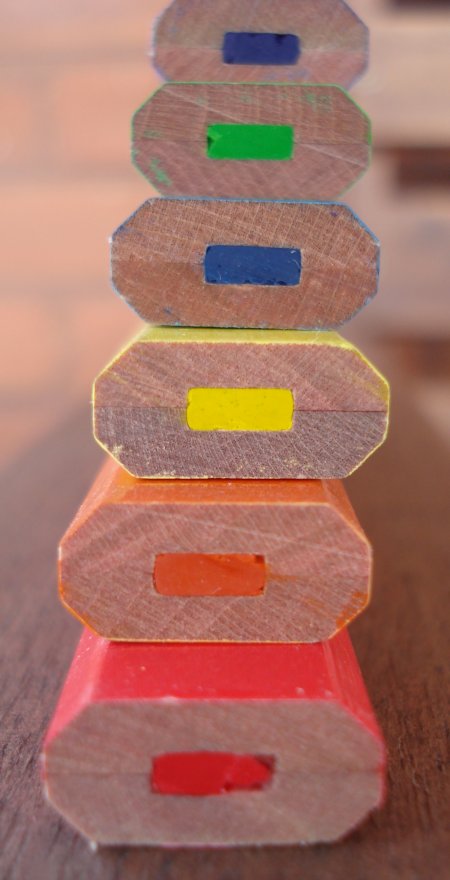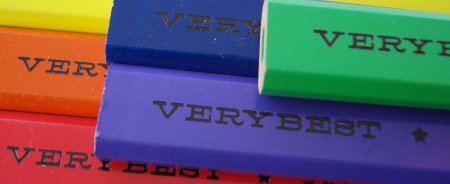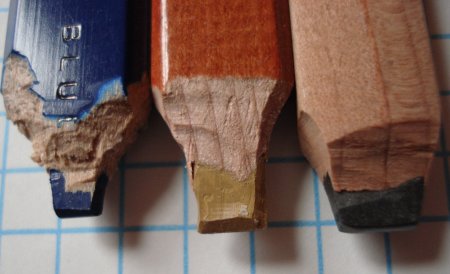
Let’s start 2008 with some colour. International Arrivals of Boulder, Colorado has released an attention grabbing set of carpenter pencils in green, yellow, purple, blue, orange and red. And this isn’t just the pencil’s paint to which we’re referring – these pencils contain the corresponding coloured leads!

Made in Taiwan, the pencils are simply labeled “carpenter pencils”, and the package states: “Sharpen pencils with carpenter pencil sharpener or with utility knife.”

Though unusual, they are not the first in this category – Rexel Cumberland / Derwent in the U.K. have released artist oriented colour pencils in carpenter pencil format.
With a Gerber pocket knife, I set about sharpening this pencil. This proved to be quite challenging – which isn’t expected. It has some sort of tough, rough wood. An included photo shows the results. Two other artist-oriented carpenter pencils – a Derwent, and a General – were easily sharpened, while the International Arrival (blue) was pure trouble.

The final verdict: Nice as wide colour leads might be, they don’t make up for this being a pencil that can’t be sharpened with standard tools. Not recommended.

Derwent and General Pencils as shown are both Incense cedar and the International Arrivals Very Best pencils which I have previously seen are basswood that is untreated with any further softening process. The higher density of untreated basswood requires better cutting tool sharpness overall in any form of woodworking application relative to Genuine Incense Cedar as treated for the slats used by General and Derwent. This explains trouble you had in sharpening. When was last time you sharpened your Gerber?
What was your experience with the quality of the color leads as opposed to other color pencils?
WoodChuck, It’s always nice to hear from you.
The Gerber was last sharpened – never. But it can still handle other pencils.
The leads were a surprise – I’m not a colour pencil artist or frequent user of colour pencils – but I’ve found that most inexpensive colour pencils not purchased at art supply stores have weak and inconsistent pigmentation. But these pencils have nice pigment saturation and write smoothly paper – I could see the format being popular with art students and artists.
Have you tired International Arrival’s carpenter pencil sharpener? You can purchase them off of their website, but I have yet to do so. I wasn’t going to spend money if I could just use a knife.
Hi Julie, thanks for the comment. I don’t think International Arrivals sells to the public. I do plan on getting some sort of appropriate sharpener in the future, but I doubt I would mail order an item like this.
You should send them an email. I had to ask if they would sell me just one, as well as ship to Canada. They said that it would be fine, but also mentioned some other things about additional charges for shipping that I was to add on at checkout, though I wasn’t sure how I was supposed to do that!
In the end it seemed like a lot of money for something like that.
Thanks for tips! I suspect my local hardware store may have one.
….I have ‘one’ Derwent Dgw. pencil in China White. For the life of me – I don’t seem to be able to find another. Any thoughts on where in the US they could be found? …thanks for the Heads-Up on the Intl. Arrival. It’s a real PITA when you cannot sharpen something in the field without a dedicated tool. Thanks.
Jim. (I’d appreciate reply to: wetstuff@totalusa.net ..as I would hate to loose this link)
This proved to be quite challenging – which isn’t expected. It has some sort of tough, rough wood.
Hi,
Retired now, I worked as a draftsman, land survey assistant and carpenter. Those who drafted with pencil will recall ruling pencils which had rectangular leads as carpenters pencils have. These pencils were sharpened with a chisel point as carpenters pencils also are, and for the same reason. When ruling a long line, a conical point wears quickly and the line thickness gets wider, unless you roll the point as you rule the line, this keeping the line weight the same the whole length of the line. By keeping the chisel point parallel with the ruler the point wears much better, and keeps the line the width you want it the whole length of the line. Common pencils, drafting pencils and carpenters pencils come in different designations, such as F, HB, H, 2H, 4H,Dynagraph, and so on. The softer carpenters pencils are fine for most work, but for fine finish work where you want very precise layouts and fine lines, a 4H carpenters pencil is very useful. The softer leads wear more quickly but produce a dark visible line on rough lumber, and hard ones wear longer, produce fine, neat, harder to see lines, and require less sharpening. With care, very fine chisel points can be produced, resulting in fine, precise lines. Where a surface is to be finished with a clear finish,it is important to be able to erase a line with an eraser or light sanding, so lightness counts. Some carpenters pencils have been produced with very thick, round leads, with the intention that the user use the extra thick lead to create a chisel point. Creating a conical point defeats the purpose. A sharp jack knife is a must have tool for a carpenter, and utility knives with thin sharp blades work very well also, for sharpening carpenters pencils. With regard to colored leads,when a layout, where you mark out a sheet or piece of wood for cutting is done, sometimes a mistake is made. Rather than scratch out the whole thing and make corrections, using a new color for the correct layout is better. Same thing with different colors of chalk lines, which carpenters use for quickly creating long, straight lines, sometimes one hundred or two hundred feet long, on wood or finished concrete floors. By the way are you familiar with lumber crayons? They come in lots of colors, are a hard, dark crayon,a half inch in diameter, and among other things, can be used to identify the correct line in a jumbled layout, by a circle, arrowhead or whatever.
How can I get these colour pencils?